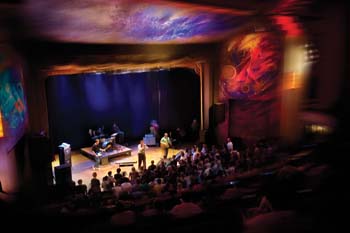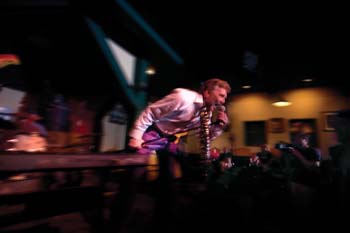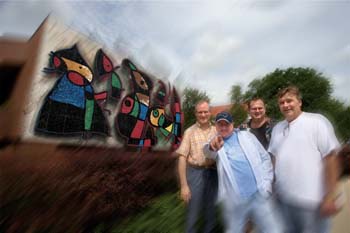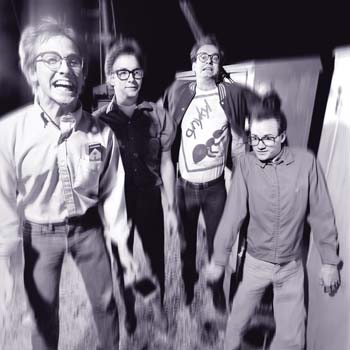
The Embarrassment remains one of the most legendary bands in Wichita’s music history.
Between 1979 and 1983 the quartet — vocalist John Nichols fs ’81, drummer Brent “Woody” Giessman fs ’81, guitarist Bill Goffrier ’80 and bassist Ron Klaus fs ’79 — became one of the best-known bands in the Midwest, without the benefit of a record label or much in the way of radio airplay.
Emerging at a time when bands such as Black Flag (based in Los Angeles), Hüsker Dü (Minneapolis) and Minor Threat (Washington, D.C.) began employing the DIY (Do It Yourself) ethic of making their own records, mounting their own tours and relying on word of mouth to promote shows, The Embarrassment (Embos to fans), never reached the commercial heights of success. Even so, the outfit is legendary, garnering respect from members of REM and Kansas-born singer-songwriter Freedy Johnston.
The group grew from the streets and subdivisions of Wichita, but also honed its craft, audio and visual, on the WSU campus –– in classrooms and art studios and at fraternity house parties, seemingly the only place the group could get gigs in its earliest days. This summer, the band reunited for three shows in Kansas: two in Wichita at the Roadhouse Blues (formerly the Coyote Club) and one in Lawrence at Liberty Hall. The gigs marked the first time in more than a decade that the four members had shared a stage.
Childhood friends Goffrier and Giessman wrote at least one song together early on (about a stuffed pink elephant, by the way) but didn’t meet again until after high school when they became neighbors. Nichols lived nearby, and the three bonded over shared musical tastes, including the Velvet Underground, Mott the Hoople, David Bowie, Alice Cooper and Bob Dylan. “We started playing music not just to entertain ourselves,” Giessman says, “but because there was a lack of the type of music we wanted to hear around here. We had to create something that didn’t exist.”
They traveled to the east and west coasts to seek out the music they’d read about in magazines or heard about in the rock ‘n’ roll underground. In those pre-Internet, pre-MTV days, small labels would place ads in independent rags or fanzines dedicated to underground music; college radio programs such as KMUW’s After Midnight would offer kids in basements and bedrooms in nowheresvilles the opportunity to hear bands from similarly under-appreciated locales such as Norman, Okla., and Athens, Ga.
Goffrier in particular was inspired by the punk scene in NYC, home of The Ramones, a band that played loud, fast-paced rock ‘n’ roll that two decades earlier (in a slower and softer setting) might have constituted safe-as-milk teenage fare.
The three not-yet Embos (Klaus had yet to join) visited New York, Los Angeles and Boston, returned with their findings and promptly began playing as a three-piece.

Roadhouse Blues.
“We didn’t really know how to play,” recalls Goffrier, “but that was the punk scene. We could start up a band based on enthusiasm and because we understood what made it entertaining. But we had to have a singer, someone to round out the band.”
At this early stage, Nichols (then on bass) left the band, and for a moment it looked like the project — whatever it was going to be called — was over.
Enter Ron Klaus. The bassist, a fellow WSU student, approached Giessman one afternoon in the pottery studio. “Ron said that he played bass and I said, ‘Great, you’re hired. We’re coming over tonight,’” the drummer recalls. “We had a great screening process,” Goffrier jokes. “A nationwide search.”
The trio learned the Stooges classic “I Wanna Be Your Dog,” wrote a batch of songs and, after several auditions, including several female vocalists, persuaded Nichols to return to the fold, this time as a vocalist. “We were young and relentless and didn’t really care what it sounded like,” says Giessman.
Before long the name The Embarrassment appeared, trumping other, less inspired monikers. “There were a couple of long lists,” says Goffrier, “including The Elastic Waistband. No one wanted that.”
The Embarrassment still enjoys some radio play on stations in Boston, where Woody Giessman and Bill Goffrier have landed; an Internet community has grown up around the group in recent years; and every once in a while an artist such as Freedy Johnston records one of the band's songs.
Once the quartet had settled into its classic lineup and had enough material to do so, it began gigging around the city at art spaces, basement parties and frat houses. “There was no real music scene here at the time,” says Giessman. “Really, the only scene that existed was T-95 playing ‘Freebird.’”
The group persuaded the then-owner of The Cedar to host a show. A few empty kegs later, Goffrier says, the owner said, “Hey, this New Wave thing is ok.” But the band had difficulties booking gigs at other locations. “Other bars didn’t want us until they heard we’d draw crowds and sell a lot of beer,” Klaus notes.
There was an artiness about the band that was in tune with other seminal punk and New Wave acts such as Talking Heads (three of whom met at the Rhode Island School of Design) and, earlier, the Velvet Underground (whose ties to Andy Warhol are well-known).
The tie between visual and aural arts was not lost on the Embos, and for good reason: All four were WSU art students (with Goffrier and Nichols studying painting, the other two ceramics). But their relationship with Wichita’s art scene wasn’t always smooth.

'80, a Boston-area art teacher; Woody Giessman fs '81, a
drug and alcohol counselor; Ron Klaus fs '79 of Arizona;
and John Nichols fs '81, who works for U.S. Air in Florida.
“We had a love/hate relationship with the art community,” says Goffrier. “I liked being more at the gut level. I liked art that was wild and primitive but where the message was still very clear. I can remember having an argument with someone about conceptual art. I thought that if you had to talk about it and explain it, it wasn’t really visual art. It seemed too pretentious.”
He recalls that there were other artists at the university who were pushing the boundaries of art, working with designs that resembled the New Wave art found in New York and LA. The group worked with fellow student Eric Cale ’87 for cover art on the Death Travels West album. “It was this iconic image that he painted,” Goffrier recalls.
The image, which Klaus calls “a Conestoga wagon built from a ’57 Chevy,” replete with red and white tail fins, remains a familiar one among fans. “The lettering he did on the cover looked to me the way that we sounded.” The band also used a pair of lithographs by WSU faculty member John Boyd for The Embarrassment EP.
Goffrier credits WSU’s Ron Christ for introducing him to a number of cutting-edge artists. The group as a whole appreciated American regionalism, while Nichols was specifically interested in the work of Edward Hopper.
“We were proud of where we were from,” Goffrier notes. “There’s nothing less about Kansas than the east coast or west coast.”
As a ceramics major, Klaus says he was inspired by the fiery elements of his craft: “Making ceramics was crude and violent and that came into my bass playing.”
In the four years that the band gigged and recorded, Embos classics such as “Sex Drive,” “Elizabeth Montgomery’s Face” and “Celebrity Art Party” began to emerge.
The songs were filled with buoyant energy, clever hooks and dramatic tension. The group also became renowned for its cover versions of rock and pop classics, each sounding more like originals than original takes on familiar tunes.
New groups, including The Clocks and The Moderns — not to mention friends of The Embarrassment inspired to start their own bands — joined the local music scene, though none resembled The Embos aesthetically. By 1983, when the group called it quits, the band had released a series of records and appeared on several compilations, but wider success was elusive.
Goffrier and Giessman eventually migrated to Boston; the former achieved recognition with the noted alternative rock group Big Dipper, while the latter drummed with the critically-acclaimed Del Fuegos.
While The Embarrassment never fully capitalized on its talents, the members say that living in Kansas at the time they did may have actually worked to the group’s benefit. “If we’d been in Boston, we might have started doing what other bands were doing just to have a place to play,” says Nichols.
And if there hadn’t been an Embarrassment in Wichita there might never have been successive generations of bands to emerge in and from the city — with eyes fixed on putting themselves and their home city on the map.

The Embarrassment Years
1979 - Four friends start a band. They buy their instruments one at a time until they have enough equipment for the task at hand. For a moment the name “The Mainliners” is attached to the fledgling enterprise, but this moniker is scrapped in favor of “The Embarrassment,” a condition with which all four have ample experience. In November, the Embos enter Hi Fidelity recording studios and record five songs. Their cover of the ‘60s proto-punk classic “Pushin’ Too Hard” is released soon after on the Bomp Records Battle of the Garages compilation.
1980 - The songs “Sex Drive” and “Patio Set” are released as a seven-inch single. Curiously, “Patio Set” is to be the A-side of the record, but is eclipsed by the anthemic “Sex Drive,” which will go on to become the band’s signature tune. Later in the year the Embos record demos of new songs with engineer Jim Skeel. The band plays numerous shows in Kansas and abroad, building a solid reputation as a can’t-miss live act.
1981 - In February the group travels to Oklahoma City and records the songs that will be released as their first 12-inch record: The Embarrassment EP. The record is labeled as having not an A and B side, but rather a “happy side” and a “snappy side.” The album cover is comprised of a pair of lithographs by WSU associate art professor John Boyd; once the covers are printed, they are manually folded and glued by the band members and friends. As the Embos continue playing live shows near and far, the record gets roundly favorable notice in the underground press and on college radio. More recordings are made with Jim Skeel; five of the resulting songs are released on a highly-regarded cassette compilation titled Fresh Sounds from Middle America. Two other songs are released on a cassette collection issued by an early incarnation of Sub Pop, the record label that would later bring the world Nirvana.
1982 - The band journeys to Crystal Clear studios in Dallas, where they record the music for their longest work to date: the “mini-LP” Death Travels West. Centering on themes of travel, death and unexplored frontiers, the songs are the most cohesive and mature yet produced by the band. The group is videotaped at an outdoor party at a place called Jerry’s Farm. Clips from that performance, including the band’s legendary re-arrangement of Michael Jackson’s “Don’t Stop ‘til You Get Enough,” can be viewed online at Google Video.
1983 - More recording is done in preparation for a full-length album (never completed). Death Travels West is released. Featuring artwork by Eric Cale ‘87, this album receives high praise from a wide range of sources, including Playboy and The Village Voice; the latter’s own “Dean of American Rock Critics,” Robert Christgau, writes that the Embos’ music “makes me sit up and say yeah.” Another contemporary critic writes, “There’s a great novel or movie to be made based on these songs. It’s the all-American record.” The kudos are welcomed, but not enough to stop the band from disintegrating. By the end of the year, the Embarrassment ceases to exist as an active recording and performing unit.
1984 - The band’s members assemble a 17-song cassette titled Retrospective; featuring previously-unreleased studio and live recordings, this collection becomes a favorite of fans.
1987 - Thanks to a “super-fan,” the abandoned tracks recorded just before the band’s implosion are released, along with the entire contents of The Embarrassment EP, on a new full-length 12-inch record titled (aptly) The Embarrassment LP.
1988 - The song “Two Week Vacation,” recorded in 1980 as a demo, is released on Homestead Records’ Human Music compilation. Simultaneously, the members of the Embarrassment reassemble to work on a new album. A live reunion show is staged in Wichita, as well.
1989 - Bar/None Records releases two Embos songs on its Time for a Change sampler. One is the band’s staple “After the Disco,” recorded in their very first 1979 session; the other is “Train of Thought,” an old standard of the band’s live shows, recorded in January. The record label also issues a promotional CD single of the song “Beautiful Day” in advance of the impending release of the group’s only “official” full-length album.
1990 - Eleven years after the band’s beginning (and seven after its end), the album God Help Us is released by Bar/None. It features 11 songs, only one of which is entirely new. The rest are reworked versions of older tunes from the band’s back catalog, including their cover of Elvis Presley’s “Burnin’ Love.”
1995 - Bar/None releases the comprehensive double album Heyday 1979-83, which collects all the studio releases and many live tracks, outtakes and alternate versions of familiar songs. The sprawling set includes a total of 42 songs.
2001 - Jim Rosencutter works with several die-hard fans to put together a compilation of live recordings titled Blister Pop. (The term was coined by the band in an offhand attempt to describe their sound.) Released by My Pal God Records, the album contains numerous “unofficial” recordings of original material and cover tunes, including Roy Orbison’s “Oh! Pretty Woman,” George Benson’s “On Broadway,” The Chambers Brothers’ “Time Has Come Today” and The Stooges’ “I Wanna Be Your Dog.”
2006 - The Embarrassment reunites for three shows — two in Wichita, one in Lawrence. All are well-attended and warmly received. New, remastered versions of some of the band’s recordings are offered for sale at the shows.
— Michael Carmody





